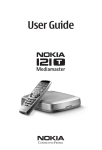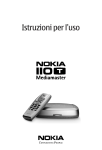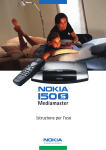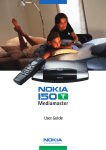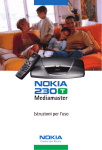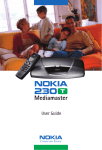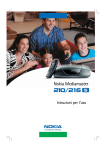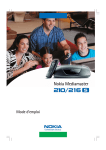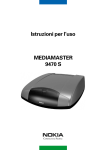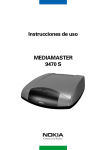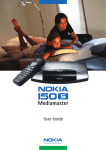Download Nokia MEDIAMASTER 110S User's Manual
Transcript
Introduction Guide
Nokia, Nokia Connecting People and Navi Bars are registered trademarks of Nokia Corporation. Other
product and company names mentioned herein may be trademarks or trade names of their owners.
Nokia operates a policy of continuous development. Therefore we reserve the right to make changes and
improvements to any of the products described in this manual without any prior notice.
Copyright © 2003 Nokia. All rights reserved.
Mediamaster
Remote control
Connecting the Mediamaster
4
5
Front and Rear panel
Connecting the Mediamaster
Preparing the remote control
Common connections
Connecting to the TV
Connecting a Video recorder
5
5
5
6
6
6
Connecting the Mediamaster
& First-time Installation
7
Conax smart card
Connecting a Hi-fi system
First-time installation general information
7
7
7
First-time installation
Switching on for the first time
and getting started
Channel search
Channel search in progress
Time adjustment
Watching satellite TV & listening to radio
Watching TV & listening to the radio
Navigating with the Navi Bars
The Menus in the Settings folder
Edit lists folder
Sorting/Filtering channels
Programme Guide: EPG
Nokia Mediamaster software
end-user license
Technical specifications
8
8
10
11
12
12
13
13
13
14
16
16
17
18
This Introduction Guide describes how to connect the Mediamaster and how to perform the first-time
installation. It also describes the main features of the product.
A more detailed User Guide in the English language is available from the Nokia.com support pages
on the Internet.
Read this before using the Mediamaster
• Do not use any power supply other than the original unit delivered with the
Mediamaster.
• Allow 10 cm of space around the Mediamaster for sufficient ventilation.
• Do not cover the Mediamaster's ventilation openings with items such as newspapers, tablecloths, curtains, etc.
• Do not place the Mediamaster on top of a heat-emitting unit.
• Do not place naked flame sources, such as lit candles, on the Mediamaster.
• Use a soft cloth and a mild solution of washing-up liquid to clean the casing.
• Do not expose the Mediamaster to dripping or splashing liquids.
• Do not place any objects filled with liquids, such as vases, on the Mediamaster.
• To give your Mediamaster extra protection, e.g. during a thunderstorm, we
recommend that you connect it via an external surge protection device.
• Do not connect or modify cables when the Mediamaster is plugged in.
• Do not remove the cover.
• Do not allow the unit to be exposed to hot, cold or humid conditions.
• Service should only be carried out at a Nokia Authorised Service Centre.
• Please note that the only way to isolate the Mediamaster completely from
the mains supply is to unplug the power supply!
GB 3
Remote control
This section describes how to operate the Mediamaster using the buttons on the remote control.
mute
Press once to turn the sound off/on (mute/unmute).
Press and hold for a few seconds to switch the
Mediamaster into standby mode. In addition,
press this button to switch the Mediamaster on.
ok
To confirm a selection.
cursor up
Move up in the menus and change to the next channel in
viewing mode.
cursor down
Move down in the menus and change to the previous
channel in viewing mode.
cursor left
Move left/change settings in menus.
Decrease the volume level in viewing mode.
cursor right
Move right/change settings in menus.
Increase the volume level in viewing mode.
opt
To display temporary settings (options) while watching TV.
Activate Channel Filtering & Sorting in Navi Bars mode.
info
Three different functions:
Pressing once will show current programme name.
Pressing twice will show information about the current
and next programme.
Pressing three times will give the 7-day programme guide
(EPG).
back
To go back one level at a time within menus.
To close the Navi Bars.
0-9
To change the channel and to select individual menu
options.
NOTE: If 0 is entered as the first digit, the TV Release
functionality is activated (see below).
0
To toggle between the Mediamaster reception or any
other reception to your TV (depending of TV model.)
navi
To open and close the Navi Bars.
txt
Press to enter Teletext (if available).
tv/radio
Toggle between TV and radio mode.
GB 4
Connecting the Mediamaster
Front and Rear panel
Antenna
for connection of the
satellite antenna
A constant green light indicates that the
Mediamaster is turned ON.
A constant red light indicates standby mode.
The light flashes red when commands from
the remote control are received.
The light flashes green during software
updates.
DC in
for connecting the cable
from the external power
supply
Slot
for a Conax smart card
TV SCART socket *
Digital audio
Digital audio output for connection to the TV
(TOS-link optical
connecttion)
Connecting the Mediamaster
The box for your Mediamaster should contain the following items:
• the Mediamaster
• a remote control with 2 AAA batteries
• a SCART cable (fully connected; 1.0 m)
• an Introduction Guide
Power supply
• a separate power supply
Preparing the remote control
• Remove the cover from the battery compartment at the bottom
of the remote control.
• Insert the 2 AAA (1.5 V) batteries as shown in the diagram,
taking care to observe the + and - markings indicated inside.
• Replace the cover.
* The TV SCART Socket
When you connect other devices to this socket, always use a fully
connected SCART cable like the one supplied. There are SCART
cables available that do not have all the pins connected,
which could reduce picture quality if you were to use them.
GB 5
Remote Control
Connecting the Mediamaster
Common connections
In this section, you will see some of the most common ways to
connect your equipment.
If you have problems with your connections and need help, contact
your retailer or Nokia Support.
Connecting to the TV
• Connect the cable from the satellite antenna to the Antenna
input on the Mediamaster.
• Connect the ordinary terrestrial TV antenna to the TV antenna
input.
• Connect a SCART cable between the main SCART socket
on the TV and the TV SCART socket on the Mediamaster.
• Switch on your TV, then plug in and switch on your Mediamaster.
You may need to select the AV (SCART) channel on your TV to
watch digital TV. In some cases, your TV will automatically
select this channel when the Mediamaster is switched on.
It is always advisable to consult the user guide that came
with your TV.
Connecting a Video recorder
• Connect the ordinary TV antenna to the TV antenna input socket
on the Video.
• Connect an RF cable from the TV/VCR output on the Video to the
antenna input socket on the TV.
• Connect a SCART cable between the main SCART socket on the TV
and the TV SCART socket on the Video.
• Connect a SCART cable between the SCART socket on the video
and the SCART socket on the Mediamaster.
• Switch on your TV, then plug in and switch on your Mediamaster.
• There should be an AV select button on your Video. This should
be selected to record digital TV.
You may need to select the AV (SCART) channel on your TV.
In some cases, your TV will automatically select this channel
when the Mediamaster is switched on.
NOTE: In this set-up, your Video has to be on or in standby
mode to watch digital TV. To record a digital channel, you will
need to select the AV (SCART) channel on your Video.
It is always advisable to consult the user guides for your
Video and TV.
GB 6
Connecting the Mediamaster & First-time Installation
Conax smart card
The Mediamaster is equipped with a built-in decoder for the
Conax encryption system.
Insert a Conax smart card fully into the slot on the back of the
Mediamaster. The gold chip must face downwards and inwards.
Connecting a Hi-fi system
It is possible to connect a TOS link cable from the Digital audio
output on the Mediamaster to a Hi-fi system that is equipped
with the corresponding audio input.
• Also use the TOS link Digital audio output for connection
to an external Dolby digital/DTS decoder.
First-time installation general information
Once you have correctly connected the Mediamaster, you will also
have to perform a "First-time installation." During this procedure,
helpful information is displayed at the bottom of the menus.
The ok button always confirms a selection within these menus,
and pressing it will take you to the next step in the installation
process. However, sometimes more than one value has to be
entered in a menu. Make all the necessary changes first.
Then, confirm them all simultaneously by pressing ok.
• You can always go back to the previous menu by pressing back.
• Use the cursor up/down buttons
to move upwards
and downwards from one line to another.
• Use the cursor left/right buttons
to change settings.
• Use the number buttons on the remote control to enter numeric
values.
GB 7
First-time installation
Switching on for the first time
and getting started
• Plug in your Mediamaster and the "First-time installation" menu
appears.
• Press ok to continue.
• Select the desired menu language using the cursor up/down
button.
• This will also become the main language for audio and
subtitling.
• Press ok to continue.
Antenna/satellite selection
• Select the “One antenna/one LNB configuration” alternative if
you have a single antenna equipped with one LNB for receiving
signals.
• Select the “Multisatellite/DiSEqC switch configuration” alternative if you have one antenna with two or four LNBs or two
antennas with one or two LNBs each for receiving signals
from a combination of satellites. In these cases you will
also need a 2-way or a 4-way DiSEqC switch.
One antenna/one LNB configuration
Select this alternative if you have one (1) LNB mounted
on the antenna.
LNB type
Select the correct LNB for your configuration. The most common
values, including Universal LNB, can be selected using the cursor
left/right button.
LNB offset voltage
If the cable from the antenna is very long, the voltage at the LNB
could be too low to change the polarisation. You can increase the
voltage to the LNB by 0.5 V.
Satellite
Select one of the pre-programmed satellites.
GB 8
First-time installation
Predefined channel
Select one of the predefined channels and adjust the antenna until
a TV picture from the predefined channel is visible on the screen.
• Press ok to confirm all settings and then continue with the
channel search procedure. See Channel Search on page 10.
Multisatellite/DiSEqC switch configuration
Select this alternative if your antenna system has more than one
LNB. In this case you must also connect the LNBs to an external
switch. Once installed, the switch automatically selects the correct
LNB for the selected channel.
This external switch is also known as a DiSEqC™ switch.
You can connect up to 4 LNBs. The selection of the different LNBs
must be controlled by an external switch.
• Select the “DiSEqC 2 input switch” alternative if you have
a 2-way DiSEqC switch.
• Select the “DiSEqC 4 input switch” alternative if you have
a 4-way DiSEqC switch.
• Select the “Mini DiSEqC switch” alternative if you have
a mini DiSEqC switch.
• For each LNB that you connect to the DiSEqC switch, some specific
settings have to be made.
As an example, the following section will describe how the LNB
intended for ASTRA will be configured for DiSEqC input 1 (A) on the
switch and the LNB intended for HOTBIRD will be configured for
DiSEqC input 2 (B).
Switch port
Select the input for each LNB that will be connected.
In this example, the DiSEqC 1 input is selected first.
DiSEqC switch
LNB type
Select the correct LNB type for your configuration, e.g. “Universal”.
LNB Offset voltage
If the cable from any of the LNBs is very long, it might be necessary
to increase the voltage to these LNBs by 0.5 V.
In most cases nothing needs to be altered here. Leave the default
value as “0 V”. If the switch does not change between horizontal
and vertical polarisation, the voltage to an LNB can be increased
later. Increase the voltage only if an LNB does not change polarisation.
GB 9
First-time installation
Satellite
In this example, select ASTRA because its LNB is connected to the
DiSEqC 1 input on the switch.
Predefined channel
Select one of the predefined channels and adjust the antenna until
a TV picture from the predefined channel is visible on the screen.
Repeat this procedure for the second DiSEqC port, but this time
select 2 from “Switch port” and HOTBIRD as the satellite.
When the configuration of both DiSEqC ports has been completed,
press ok.
A confirmation that the DiSEqC ports have been configured will be
shown.
• Press ok to carry out the channel search procedure.
Channel search
The Channel search procedure can be carried out in different ways.
The menu will look different depending on what option you
selected in the “Antenna/satellite selection” menu.
If you selected “One antenna/one LNB configuration”, select
“Automatic”, “Manual” or “Advanced Manual” search.
If you selected “Multisatellite/DiSEqC switch configuration” you also
must indicate which satellite you wish to search from, using the
cursor left/cursor right button.
The “Use Predefined channels” alternative is explained on the next
page.
Automatic search alternatives
Three different alternatives are possible:
1. All channels will search for and download all available
channels.
2. Free & Conax encrypted channels will search for and
download free channels and those encrypted by Conax.
3. Free channels only will download only free channels.
Press ok to start searching for channels.
Note! Later on the Automatic Channel update will only update
dynamically the channels which you have selected here to be
installed.
GB 10
First-time installation
Manual and Advanced channel search
It is also possible to perform Manual and Advanced channel
searches. The information that must be entered in those menus
is available in satellite TV magazines or on the Internet.
The “Use Predefined channels” alternative
The Mediamaster is pre-programmed with channels from the Astra
satellites on 19.2 °E, Hotbird 13 ° E, Sirius 5 °E and Thor/Intelsat 0,8 °W.
However, not all channels from each of those satellites are preprogrammed.
When you select this search alternative, no direct channel search from
the satellite(s) is performed.
Instead, channel folders (named “Favourites”) containing the preprogrammed channels will be placed in Navi Bars.
Channel search in progress
This menu will be shown while the Mediamaster is searching for TV
and radio channels. The Channels found during the Channel search
will be listed on the screen.
Please note that the search procedure may take a few minutes. You
can stop an ongoing search procedure at any time by pressing ok.
When the search procedure has ended, a message will tell you how
many TV and radio channels have been found.
• Press ok to continue.
About TV and Radio folders
TV, Radio and Favourite folders will be automatically created and
placed in Navi Bars.
The TV and Radio folder names will be satellite specific and dependent on the Antenna/Satellite selection you made (see page 8).
Navi Bars
The TV and Radio Favourite folders will contain predefined
channels from the satellites (Astra, Hotbird, Sirius and Thor) you
specified in the Antenna/Satellite selection (see page 8).
The following folders will be created and placed in the Navi Bars:
1. One TV folder named Astra (Hotbird, Sirius and Thor) containing
all TV channels found during the search procedure. This folder is
symbolised by a TV icon.
2. One Radio folder named Astra (Hotbird, Sirius and Thor) containing all Radio channels found during the search procedure. This
folder is symbolised by a Radio icon.
Folders
GB 11
First-time installation
3. One more TV folder named Favourites containing a predefined
language-dependent favourite list with channels from Astra
(Hotbird, Sirius and Thor). This folder is symbolised by a TV icon.
4. One more Radio folder named Favourites containing a predefined language-dependent favourite channel list with
channels from Astra (Hotbird, Sirius and Thor). This folder is
symbolised by a Radio icon.
5. One All Radio folder containing all Radio channels found during
the search procedure. This folder is symbolised by a Radio icon.
Optional TV and Radio folders
For example, if you did select Hispasat in the Antenna/Satellite
selection (See page 8), a TV and a Radio folder, each of them named
Hispasat, will be created in Navi Bars.
An All Radio folder will also be created.
No Favourite folders will be created.
Time adjustment
If necessary, the time is adjusted by using cursor up/down,
±1/2 an hour at a time. You can also adjust the minutes
by using cursor left/right.
Now the first-time installation is finished. Press ok to start
watching satellite channels.
Watching satellite TV & listening to radio
If no TV channel is automatically shown after you have finished the
installation procedure,
1. Step up or down with the
channel.
buttons to select another
2. If that does not work, open the Navi Bars (see next page)
with the navi button. Select another channel from any of
the TV folders.
GB 12
Navi Bars
Watching TV & listening to the radio
Navigating with the Navi Bars
Navi Bars
Navi Bars are used for selecting TV/Radio channels and to enter
menus in which you can create different settings.
Bookmark
name
Bookmark
1. Display Navi Bars by pressing the navi button; to hide them, press
the navi or back button.
2. When Navi Bars are displayed, you can move the folders in
horizontal and vertical directions with the
cursor
buttons.
The horizontal row contains folders, e.g. Astra TV and Astra Radio
folders, Favourite folders and a Settings folder. Each folder contains
one or more bookmarks.
• To move a folder into focus, use the
buttons.
• When a folder is in focus the bookmarks will be shown.
• You select a bookmark using the
buttons.
• To confirm the selection of, e.g., a TV channel or to open a bookmark, press the ok button.
Highlighted
bookmark
Folder
name
Folder
Information box
Below the horizontal folder bar, there is an Information box for the
currently highlighted bookmark.
When scrolling through TV or radio channels, the programmes can
be marked with the following symbols in the Information box:
= a new channel you have not yet visited
= the channel is locked by the user
= the channel is encrypted
The Menus in the Settings folder
From the Settings folder in the Navi Bar you have access to different
bookmarks containing Menus.
In the figure to the right the Settings folder with the User bookmark
is in focus.
When you try to open some of the menus contained in the folders
you will be asked to enter an access code. This code is pre-set to
1234 in the factory.
Press ok to open the User Menu.
Press info to get some information about the Settings folder
currently in focus.
From the Menus you can make different settings that will affect the
performance of the Mediamaster. For example, in the User Preferences Menu shown in the figure to the right you can change settings for the Banner time-out, Volume bar time-out and so on. At
the bottom part of each menu you get some useful information
about what will be affected.
GB 13
Watching TV & listening to the radio
Edit lists folder
The TV folder may contain a lot of channels. By creating your own
lists you can make it easier to handle channels.
You can create and edit favourite channel lists in these menus.
Select list
If you have several lists and want to make changes in them, select
which list by using the
buttons.
Create list for
Create your own lists containing the channels you most frequently
watch. Give each list a specific name, e.g., "News" or "Kids". The new
lists you create will appear as a new folder in the horizontal part of
the Navi Bars.
When a list is selected, you see only those channels defined in the
list.
You can create separate lists for TV and radio channels.
Enter the name of a list
• Press the number button corresponding to the character you
want: once for the first character, twice for the second and so on.
• Before entering the next character, wait for the short automatic
delay before the cursor moves to the next character position.
• The available characters are listed below:
1
2
3
4
5
*#&%=,!;-+)/ \$@^1
abc2ÅÄÁÁÂÃ
def3ÉÉËÊ
ghi4ÎÏÍÌ
jkl5
6
7
8
9
0
mno6ÖÔÑÓÒ
pqrs7$
tuv8ÜÙÚ
wxyz9
space and 0
• Toggle between uppercase and lowercase letters with opt.
• To insert a space, press the number button 0.
• If you make a mistake, you can remove characters by pressing
txt as many times as needed.
• When you have entered the list name, press ok.
• Go to "Add/Delete Channels" to add channels to the list.
GB 14
Watching TV & listening to the radio
Delete selected list
If you want to completely delete a list, first select the list with
the
buttons on the line "Select list". Then, move down to
"Delete selected list" and press ok.
Rename selected list
Give the list a new name. Refer to "Create list" on the previous page.
Add/Delete channels
From this menu, you add and remove the channels in your lists.
A channel is added or removed from the list by pressing info.
The square on the righthand side of a line will be empty to denote
a removed channel, and will contain an " " for added channels.
Three different symbols can be shown next to the channel name:
for a new channel you have not previously visited, for a channel
locked by the user and for an encrypted channel.
• Move to the desired channel(s) with the
buttons.
• Press opt if you want to preview the channel.
• Add/remove a channel by pressing info.
• When you are ready, confirm the selections and exit the menu by
pressing ok.
Rearrange channels
This lets you arrange the order of the channels within your lists.
• With the button, mark the channel you want to move
to a new position.
• Move the channel to the desired position with
the
buttons,
• then press the
button.
• Press ok to confirm the new position.
Lock channels
To open this menu, you will be asked to enter your access code.
The access code is set to 1234 at the factory.
You can lock (and later unlock) channels on any of the lists in order
to prevent your children from watching them, etc.
• Select the channel you want to lock and press info.
Repeat the procedure for each channel you want to lock.
• Press opt if you want to preview the channel.
GB 15
Watching TV & listening to the radio
• Press ok to confirm.
A locked channel will be marked with an " " symbol.
• You must enter your access code before you can watch a locked
channel.
Sorting/Filtering channels
You can sort and display the channel lists stored in the TV and
Radio folders during channel search in installation.
Note ! Sorting and filtering does not apply for Favourite folders.
When any of the TV or Radio folders are in focus in the Navi Bars,
press the opt button on the remote control.
• You can sort the order of the channels to displayed alphabetically or numerically in the folders.
• You can select the networks on which you filter the channel lists
(depending on network operator)
• You can optimise the number of channels to be displayed by
filtering channels according to their encryption:
Free, Free & Conax, All
Electronic Programme Guide: EPG
By pressing the info button three times while watching a channel
you get access to the Mediamaster EPG (Electronic Programme
Guide.)
In the EPG you will find information about the programmes for the
current day and for the following seven days (provided that this
information is included in the channel transmission from the
distributor.)
You may also select the Type of programme you want information
about, e. g. Movie, Sports or Music.
Use the arrow buttons to navigate within the guide. Exit the guide
by pressing the info or back button.
GB 16
Nokia Mediamaster software end-user license
IMPORTANT: READ THE NOKIA CORPORATION, NOKIA HOME COMMUNICATIONS END-USER SOFTWARE AGREEMENT CAREFULLY BEFORE USING THE SOFTWARE
This Software Agreement ("Agreement") is between You (either an individual or an entity), the End User, and Nokia Corporation, Nokia Home Communications
("Nokia"). The Agreement authorizes You to use the Software specified in Clause 1 below and which is included in this Nokia digital TV receiver. This is an agreement
on end-user rights and not an agreement concerning sale.
Read this Agreement carefully before using the Software. By using this Nokia digital TV receiver, You agree to the terms and conditions of this Agreement. If You
do not agree to all of the terms and conditions of this Agreement, return this Nokia digital TV receiver and accompanying documentation to the place of purchase.
YOU AGREE THAT YOUR USE OF THE SOFTWARE ACKNOWLEDGES THAT YOU HAVE READ THIS AGREEMENT, UNDERSTAND IT, AND AGREE TO BE BOUND BY ITS TERMS AND
CONDITIONS.
1. SOFTWARE. As used in this Agreement, the term "Software" means, collectively: (i) the software product identified above (ii) digital images, stock photographs, clip art, or other artistic works ("Stock Files") (iii) related explanatory
written materials and any other possible documentation related thereto
("Documentation"); (iv) fonts, and (v) upgrades, modified versions, updates,
additions, and copies of the Software, if any, licensed to You by Nokia under
this Agreement.
2. END-USER RIGHTS AND USE. Nokia grants to You non-exclusive, non-transferable end-user rights to use the Software on this Nokia digital TV receiver only.
3. LIMITATIONS ON END-USER RIGHTS. You may not copy, distribute, or make derivative works of the Software except as follows:
(a) You may transfer all your rights to the Software at the same time as You
transfer this Nokia digital TV receiver on a permanent basis, provided that You
transfer this Nokia digital TV receiver and all copies of the related Documentation, do not retain any copies for yourself, and the recipient agrees to the terms
and conditions of this Agreement.
(b) You may not use, modify, translate, reproduce, or transfer the right to use
the Software or copy the Software except as expressly provided in this Agreement.
(c) You may not resell, except as set forth in clause 3 (a), sub-license, rent, lease,
or lend the Software.
(d) You may not reverse engineer, decompile, disassemble, or otherwise attempt to discover the source code of the Software (except to the extent that
this restriction is expressly prohibited by law) or create derivative works based
on the Software.
(e) Unless stated otherwise in the Documentation, You shall not display, modify, reproduce, or distribute any of the possible Stock Files included with the
Software. In the event that the Documentation allows You to display the Stock
Files, You shall not distribute the Stock Files on a stand-alone basis, i.e. in circumstances in which the Stock Files constitute the primary value of the product being distributed. You should review the "Readme" files (if any) associated
with such Stock Files that You use to ascertain what rights You have with respect to such materials. Stock Files may not be used in the production of libellous, defamatory, fraudulent, infringing, lewd, obscene, or pornographic
material or in any otherwise illegal manner. You may not register or claim any
rights in the Stock Files or derivative works thereof.
(f) You agree that You shall only use the Software in a manner that complies
with all applicable laws in the jurisdiction in which You use the Software, including, but not limited to, applicable restrictions concerning copyright and
other intellectual property rights.
INTERRUPTION OF BUSINESS, LOSS OF BUSINESS INFORMATION, OR FOR ANY SPECIAL, DIRECT, INDIRECT, INCIDENTAL, ECONOMIC, COVER, PUNITIVE, SPECIAL, OR
CONSEQUENTIAL DAMAGES, HOWEVER CAUSED AND WHETHER ARISING UNDER
CONTRACT, TORT, NEGLIGENCE, OR OTHER THEORY OF LIABILITY ARISING OUT OF
THE USE OF OR INABILITY TO USE THE SOFTWARE, EVEN IF NOKIA OR ITS LICENSORS
OR AFFILIATES ARE ADVISED OF THE POSSIBILITY OF SUCH DAMAGES. BECAUSE
SOME COUNTRIES/STATES/JURISDICTIONS DO NOT ALLOW THE EXCLUSION OF LIABILITY, BUT MAY ALLOW LIABILITY TO BE LIMITED, IN SUCH CASES, NOKIA, ITS EMPLOYEES OR LICENSORS OR AFFILIATES' LIABILITY SHALL BE LIMITED TO U.S. $50.
Nothing contained in this Agreement shall prejudice the statutory rights of any
party dealing as a consumer. Nokia is acting on behalf of its employees and licensors or affiliates for the purpose of disclaiming, excluding, and/or restricting obligations, and liability as provided in this clause 7, but in no other
respects and for no other purpose.
8. EXPORT CONTROL. The Software, including technical data, includes cryptographic software subject to export controls under the U.S. Export Administration Regulations ("EAR") and may be subject to import or export controls in
other countries. The EAR prohibits the use of the Software and technical data
by a Government End User, as defined hereafter, without a license from the U.S.
government. A Government End User is defined in Part 772 of the EAR as "any
foreign central, regional, or local government department, agency, or other
entity performing governmental functions; including governmental research
institutions, governmental corporations, or their separate business units (as
defined in part 772 of the EAR) which are engaged in the manufacture or distribution of items or services controlled on the Wassenaar Munitions List, and
international governmental organizations. This term does not include: utilities
(telecommunications companies and Internet Service Providers; banks and financial institutions; transportation; broadcast or entertainment; educational
organizations; civil health and medical organizations; retail or wholesale
firms; and manufacturing or industrial entities not engaged in the manufacture or distribution of items or services controlled on the Wassenaar Munitions
List.)" You agree to strictly comply with all applicable import and export regulations and acknowledge that You have the responsibility to obtain licenses to
export, re-export, transfer, or import the Software. You further represent that
You are not a Government End User as defined above, and You will not transfer
the Software to any Government End User without a license.
9. CONTACT DETAILS. If You want to contact Nokia in respect of this Agreement,
contact Nokia at the following address:
Nokia Home Communications
4. COPYRIGHT. The Software and all rights, without limitation including proprietary rights therein, are owned by Nokia and/or its licensors and affiliates and
are protected by international treaty provisions and all other applicable national laws of the country in which it is being used. The structure, organization,
and code of the Software are the valuable trade secrets and confidential information of Nokia and/or its licensor and affiliates. You must not copy the Software
Itämerenkatu 11-13
5. COMMENCEMENT & TERMINATION. This Agreement is effective from the first
date You use this Nokia digital TV receiver. You may terminate this Agreement
at any time by returning, at Your own costs, this Nokia digital TV receiver, and
all related materials provided by Nokia. Your end-user rights automatically and
immediately terminate without notice from Nokia if You fail to comply with
any provision of this Agreement. In such an event, You must immediately return at Your own cost, this Nokia digital TV receiver, and all related material to
the place of purchase.
10. APPLICABLE LAW & GENERAL PROVISIONS.
6. NO OTHER OBLIGATIONS. This Agreement creates no obligations on the part
of Nokia other than as specifically set forth herein.
7. LIMITATION OF LIABILITY. TO THE MAXIMUM EXTENT PERMITTED BY APPLICABLE
LAW, IN NO EVENT SHALL NOKIA, ITS EMPLOYEES OR LICENSORS OR AFFILIATES BE
LIABLE FOR ANY LOST PROFITS, REVENUE, SALES, DATA, OR COSTS OF PROCUREMENT OF SUBSTITUTE GOODS OR SERVICES, PROPERTY DAMAGE, PERSONAL INJURY,
GB 17
00180 Helsinki
FINLAND
This Agreement is governed by the laws of Finland. All disputes arising from or
relating to this Agreement shall be settled by a single arbitrator appointed by
the Central Chamber of Commerce of Finland. The arbitration procedure shall
take place in Helsinki, Finland in the English language. If any part of this Agreement is found void and unenforceable, it will not affect the validity of the balance of the Agreement, which shall remain valid and enforceable according to
its terms. This Agreement may only be modified in writing by an authorized officer of Nokia. This is the entire agreement between Nokia and You relating to
the Software, and it supersedes any prior representations, discussions, undertakings, end-user agreements, communications, or advertising relating to the
Software.
Technical specifications
Transmission Standards
DVB, MPEG 2
Front panel
One LED indicator
LNB/Tuner input
External power supply
LNB connector
F-type
Input
110-240 V, 50-60 Hz
RF input frequency
950 - 2150 MHz
Power consumption
max 15 W
RF input level
-25 to -65 dBm
RF impedance
75 Ω
Power consumption
in standby mode
max 2 W
Input bandwidth
36 MHz
Supported TV systems
PAL B/G, I and SECAM
General data
QPSK receiver module
The model code, variant and serial number, are located on
a label on the underside of the receiver.
SCPC & MCPC
The Conax Conditional Access (CA) System is embedded.
DC power
to the Mediamaster
TV SCART
10-15 V
1 Vpp (±1 dB) / 75 Ω
Operating temperature
+5°C to +45°C
Audio output
0.5 Vrms / RL >10 k Ω
Storage temperature
- 40°C to +65°C
RGB output
Internal RGB
Humidity
25 to 75% rel. humidity
RGB bandwidth
5.8 MHz ±3 dB
Operating distance for
remote control
Circa 10 m
Fast blanking output
Internal
167 x 165 x 40 mm
Status output
0/6/12 V / RL >10 k Ω
Dimensions (w x d x h)
Optical
TOS-link connector
For PCM, DTS and Dolby Digital
Bitstream audio output
signals
Audio decoder
MPEG-1 layer I and II
Video output
GB 18
Nokia is a registered trademark of Nokia Corporation
www.nokia.com
00005853.00























